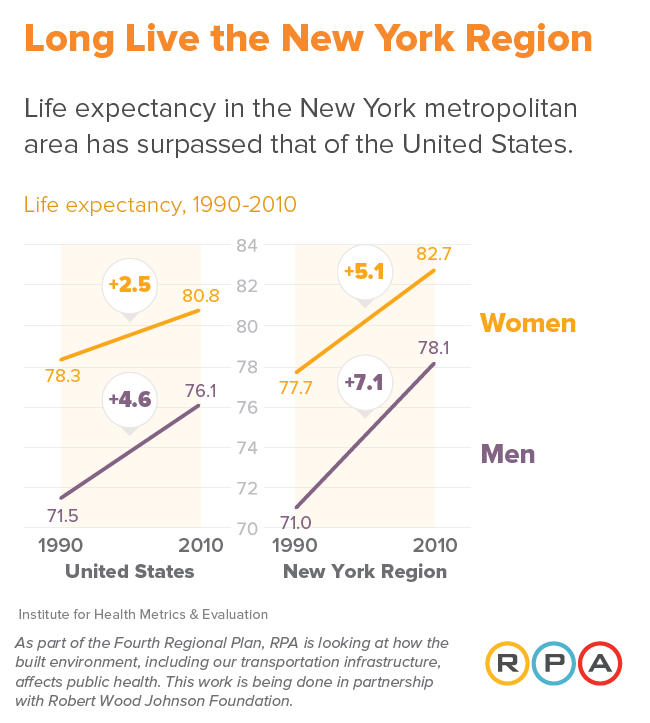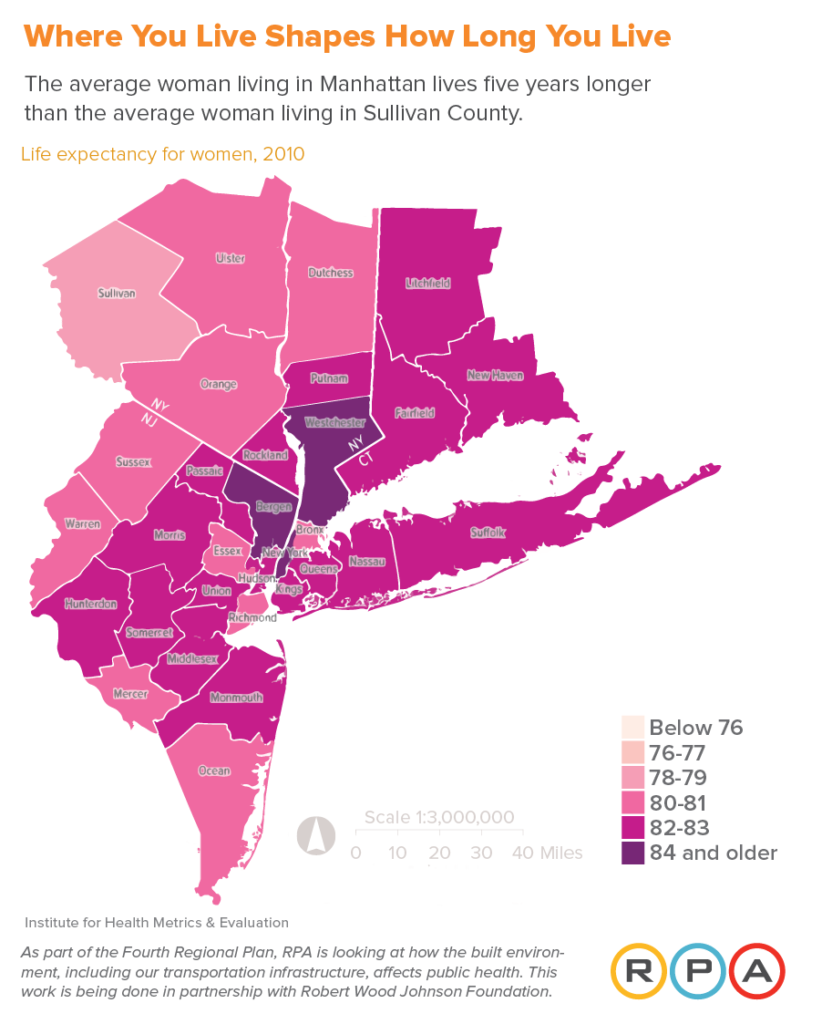The New York region is healthier than ever before. It used to be that life expectancy in the metropolitan area was below that of the U.S.. Today, New Yorkers live longer than the average American. As RPA’s new report, The State of the Region’s Health, highlights, the health of residents in our region is heavily influenced by the urban environments where they live, work and play. The report, created with the support of the Robert Wood Johnson Foundation, finds that smart, health-conscious urban planning has produced significant dividends for health outcomes in our region. The development of walkable streets and investments in accessible transit systems has transformed our urban areas into a built-in gym, promoting exercise in our everyday lives. Safer streets and fewer drivers has led to fewer deaths from from motor vehicle crashes in the New York region than in the U.S. overall. And people in the region are typically well connected to a variety of destinations. In fact, residents of the region living in poverty have better access to jobs, supermarkets and parks than the overall population. While many investments in accessible urban systems and integrated land use have promoted healthier communities, planning decisions that have reinforced inequality and segregation have led to adverse health outcomes for racial and ethnic minorities and lower-income residents of our region. In some parts of the New York metropolitan area, black individuals live as much as five years less on average than their white and Hispanic counterparts. These disparities are also seen in different parts of the region based on income. People living in poorer areas such as the Bronx and Sullivan County have a much lower life expectancy than those living in wealthier communities, such as Morris county in New Jersey.
The report, created with the support of the Robert Wood Johnson Foundation, finds that smart, health-conscious urban planning has produced significant dividends for health outcomes in our region. The development of walkable streets and investments in accessible transit systems has transformed our urban areas into a built-in gym, promoting exercise in our everyday lives. Safer streets and fewer drivers has led to fewer deaths from from motor vehicle crashes in the New York region than in the U.S. overall. And people in the region are typically well connected to a variety of destinations. In fact, residents of the region living in poverty have better access to jobs, supermarkets and parks than the overall population. While many investments in accessible urban systems and integrated land use have promoted healthier communities, planning decisions that have reinforced inequality and segregation have led to adverse health outcomes for racial and ethnic minorities and lower-income residents of our region. In some parts of the New York metropolitan area, black individuals live as much as five years less on average than their white and Hispanic counterparts. These disparities are also seen in different parts of the region based on income. People living in poorer areas such as the Bronx and Sullivan County have a much lower life expectancy than those living in wealthier communities, such as Morris county in New Jersey.  The siting of industrial uses and the economic forces that drive where lower-income residents can afford to live and the resources they have access to also largely factor into their health outcomes. For example, Hispanic children are twice as likely to live in areas with high air pollution as white children. Children of color are also far more likely to live in low performing public school districts. This can mean lower-quality school lunches and unhealthy physical conditions in schools, not to mention the potential to lose out on the long-term health benefits of continued education.
Learn more about the state of our region’s health and how urban planning has and can shape the future health of metropolitan residents in our new report: The State of the Region’s Health (pdf). UPDATE: As part of the project, RPA held a panel discussion Monday at the WNYC Greene Space. The event, moderated by Mary Harris, the host and managing editor of WNYC program Only Human, featured a discussion on how buildings, streets, housing, transportation systems, parks, access to jobs and other aspects of the physical environment affect health, and how urban planning can be used to improve health outcomes. Panelists included: Jo Ivey Boufford, MD, President, the New York Academy of Medicine; Daniel Hernandez, Deputy Commissioner, New York City Housing Preservation & Development; and Walter Barrientos, Lead Organizer, Make the Road New York. Watch the presentation & panel discussion below.
The siting of industrial uses and the economic forces that drive where lower-income residents can afford to live and the resources they have access to also largely factor into their health outcomes. For example, Hispanic children are twice as likely to live in areas with high air pollution as white children. Children of color are also far more likely to live in low performing public school districts. This can mean lower-quality school lunches and unhealthy physical conditions in schools, not to mention the potential to lose out on the long-term health benefits of continued education.
Learn more about the state of our region’s health and how urban planning has and can shape the future health of metropolitan residents in our new report: The State of the Region’s Health (pdf). UPDATE: As part of the project, RPA held a panel discussion Monday at the WNYC Greene Space. The event, moderated by Mary Harris, the host and managing editor of WNYC program Only Human, featured a discussion on how buildings, streets, housing, transportation systems, parks, access to jobs and other aspects of the physical environment affect health, and how urban planning can be used to improve health outcomes. Panelists included: Jo Ivey Boufford, MD, President, the New York Academy of Medicine; Daniel Hernandez, Deputy Commissioner, New York City Housing Preservation & Development; and Walter Barrientos, Lead Organizer, Make the Road New York. Watch the presentation & panel discussion below.
 The report, created with the support of the Robert Wood Johnson Foundation, finds that smart, health-conscious urban planning has produced significant dividends for health outcomes in our region. The development of walkable streets and investments in accessible transit systems has transformed our urban areas into a built-in gym, promoting exercise in our everyday lives. Safer streets and fewer drivers has led to fewer deaths from from motor vehicle crashes in the New York region than in the U.S. overall. And people in the region are typically well connected to a variety of destinations. In fact, residents of the region living in poverty have better access to jobs, supermarkets and parks than the overall population. While many investments in accessible urban systems and integrated land use have promoted healthier communities, planning decisions that have reinforced inequality and segregation have led to adverse health outcomes for racial and ethnic minorities and lower-income residents of our region. In some parts of the New York metropolitan area, black individuals live as much as five years less on average than their white and Hispanic counterparts. These disparities are also seen in different parts of the region based on income. People living in poorer areas such as the Bronx and Sullivan County have a much lower life expectancy than those living in wealthier communities, such as Morris county in New Jersey.
The report, created with the support of the Robert Wood Johnson Foundation, finds that smart, health-conscious urban planning has produced significant dividends for health outcomes in our region. The development of walkable streets and investments in accessible transit systems has transformed our urban areas into a built-in gym, promoting exercise in our everyday lives. Safer streets and fewer drivers has led to fewer deaths from from motor vehicle crashes in the New York region than in the U.S. overall. And people in the region are typically well connected to a variety of destinations. In fact, residents of the region living in poverty have better access to jobs, supermarkets and parks than the overall population. While many investments in accessible urban systems and integrated land use have promoted healthier communities, planning decisions that have reinforced inequality and segregation have led to adverse health outcomes for racial and ethnic minorities and lower-income residents of our region. In some parts of the New York metropolitan area, black individuals live as much as five years less on average than their white and Hispanic counterparts. These disparities are also seen in different parts of the region based on income. People living in poorer areas such as the Bronx and Sullivan County have a much lower life expectancy than those living in wealthier communities, such as Morris county in New Jersey.  The siting of industrial uses and the economic forces that drive where lower-income residents can afford to live and the resources they have access to also largely factor into their health outcomes. For example, Hispanic children are twice as likely to live in areas with high air pollution as white children. Children of color are also far more likely to live in low performing public school districts. This can mean lower-quality school lunches and unhealthy physical conditions in schools, not to mention the potential to lose out on the long-term health benefits of continued education.
Learn more about the state of our region’s health and how urban planning has and can shape the future health of metropolitan residents in our new report: The State of the Region’s Health (pdf). UPDATE: As part of the project, RPA held a panel discussion Monday at the WNYC Greene Space. The event, moderated by Mary Harris, the host and managing editor of WNYC program Only Human, featured a discussion on how buildings, streets, housing, transportation systems, parks, access to jobs and other aspects of the physical environment affect health, and how urban planning can be used to improve health outcomes. Panelists included: Jo Ivey Boufford, MD, President, the New York Academy of Medicine; Daniel Hernandez, Deputy Commissioner, New York City Housing Preservation & Development; and Walter Barrientos, Lead Organizer, Make the Road New York. Watch the presentation & panel discussion below.
The siting of industrial uses and the economic forces that drive where lower-income residents can afford to live and the resources they have access to also largely factor into their health outcomes. For example, Hispanic children are twice as likely to live in areas with high air pollution as white children. Children of color are also far more likely to live in low performing public school districts. This can mean lower-quality school lunches and unhealthy physical conditions in schools, not to mention the potential to lose out on the long-term health benefits of continued education.
Learn more about the state of our region’s health and how urban planning has and can shape the future health of metropolitan residents in our new report: The State of the Region’s Health (pdf). UPDATE: As part of the project, RPA held a panel discussion Monday at the WNYC Greene Space. The event, moderated by Mary Harris, the host and managing editor of WNYC program Only Human, featured a discussion on how buildings, streets, housing, transportation systems, parks, access to jobs and other aspects of the physical environment affect health, and how urban planning can be used to improve health outcomes. Panelists included: Jo Ivey Boufford, MD, President, the New York Academy of Medicine; Daniel Hernandez, Deputy Commissioner, New York City Housing Preservation & Development; and Walter Barrientos, Lead Organizer, Make the Road New York. Watch the presentation & panel discussion below.
Related Lab Posts
Dec 2024
Nov 2024
Nov 2024
